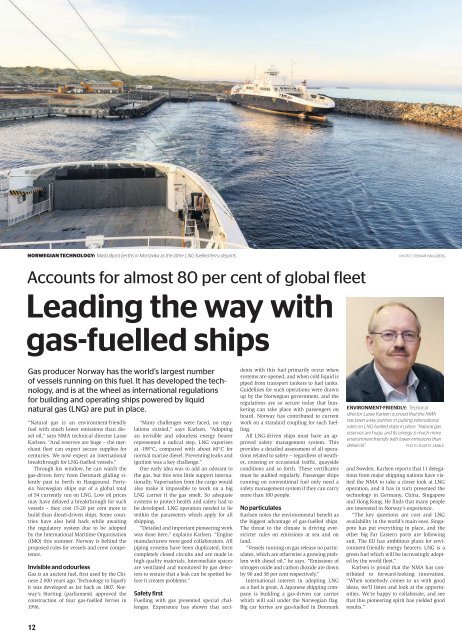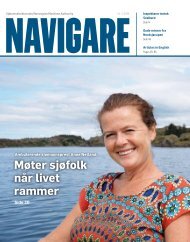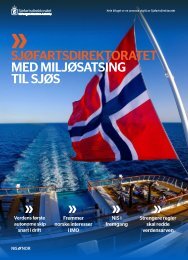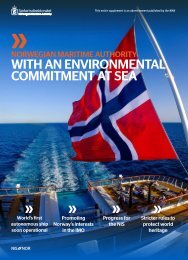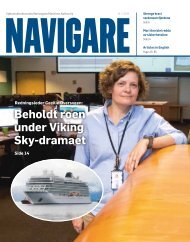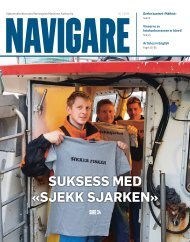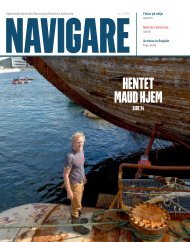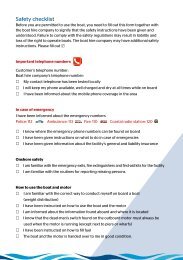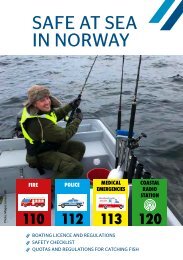Joining forces for our maritime future
The Norwegian Maritime Authority has strengthened its accessibility and service, and is now working with the industry to reinforce Norway's maritime sector for the future. A special Nor-Shipping 2015 publication from the NMA.
The Norwegian Maritime Authority has strengthened its accessibility and service, and is now working with the industry to reinforce Norway's maritime sector for the future. A special Nor-Shipping 2015 publication from the NMA.
Create successful ePaper yourself
Turn your PDF publications into a flip-book with our unique Google optimized e-Paper software.
This entire supplement is an advertisement from the NMA<br />
NORWEGIAN TECHNOLOGY: Mastrafjord berths in Mortavika as the other LNG-fuelled ferry departs. .<br />
Accounts <strong>for</strong> almost 80 per cent of global fleet<br />
PHOTO: STEINAR HAUGBERG<br />
Leading the way with<br />
gas-fuelled ships<br />
Gas producer Norway has the world’s largest number<br />
of vessels running on this fuel. It has developed the technology,<br />
and is at the wheel as international regulations<br />
<strong>for</strong> building and operating ships powered by liquid<br />
natural gas (LNG) are put in place.<br />
“Natural gas is an environment-friendly<br />
fuel with much lower emissions than diesel<br />
oil,” says NMA technical director Lasse<br />
Karlsen. “And reserves are huge – the merchant<br />
fleet can expect secure supplies <strong>for</strong><br />
centuries. We now expect an international<br />
breakthrough <strong>for</strong> LNG-fuelled vessels.”<br />
Through his window, he can watch the<br />
gas-driven ferry from Denmark gliding silently<br />
past to berth in Haugesund. Fortysix<br />
Norwegian ships out of a global total<br />
of 54 currently run on LNG. Low oil prices<br />
may have delayed a breakthrough <strong>for</strong> such<br />
vessels – they cost 15-20 per cent more to<br />
build than diesel-driven ships. Some countries<br />
have also held back while awaiting<br />
the regulatory system due to be adopted<br />
by the International Maritime Organisation<br />
(IMO) this summer. Norway is behind the<br />
proposed rules <strong>for</strong> vessels and crew competence.<br />
Invisible and od<strong>our</strong>less<br />
Gas is an ancient fuel, first used by the Chinese<br />
2 000 years ago. Technology to liquefy<br />
it was developed as far back as 1807. Norway’s<br />
Storting (parliament) approved the<br />
construction of f<strong>our</strong> gas-fuelled ferries in<br />
1996.<br />
“Many challenges were faced, no regulations<br />
existed,” says Karlsen. “Adopting<br />
an invisible and od<strong>our</strong>less energy bearer<br />
represented a radical step. LNG vaporises<br />
at -198°C, compared with about 60°C <strong>for</strong><br />
normal marine diesel. Preventing leaks and<br />
ignition was a key challenge.”<br />
One early idea was to add an odorant to<br />
the gas, but this won little support internationally.<br />
Vaporisation from the cargo would<br />
also make it impossible to work on a big<br />
LNG carrier if the gas smelt. So adequate<br />
systems to protect health and safety had to<br />
be developed. LNG operation needed to lie<br />
within the parameters which apply <strong>for</strong> all<br />
shipping.<br />
“Detailed and important pioneering work<br />
was done here,” explains Karlsen. “Engine<br />
manufacturers were good collaborators. All<br />
piping systems have been duplicated, <strong>for</strong>m<br />
completely closed circuits and are made in<br />
high-quality materials. Intermediate spaces<br />
are ventilated and monitored by gas detectors<br />
to ensure that a leak can be spotted be<strong>for</strong>e<br />
it creates problems.”<br />
Safety first<br />
Fuelling with gas presented special challenges.<br />
Experience has shown that accidents<br />
with this fuel primarily occur when<br />
systems are opened, and when cold liquid is<br />
piped from transport tankers to fuel tanks.<br />
Guidelines <strong>for</strong> such operations were drawn<br />
up by the Norwegian government, and the<br />
regulations are so secure today that bunkering<br />
can take place with passengers on<br />
board. Norway has contributed to current<br />
work on a standard coupling <strong>for</strong> such fuelling.<br />
All LNG-driven ships must have an approved<br />
safety management system. This<br />
provides a detailed assessment of all operations<br />
related to safety – regardless of weather,<br />
crossing or occasional traffic, quayside<br />
conditions and so <strong>for</strong>th. These certificates<br />
must be audited regularly. Passenger ships<br />
running on conventional fuel only need a<br />
safety management system if they can carry<br />
more than 100 people.<br />
No particulates<br />
Karlsen notes the environmental benefit as<br />
the biggest advantage of gas-fuelled ships.<br />
The threat to the climate is driving everstricter<br />
rules on emissions at sea and on<br />
land.<br />
“Vessels running on gas release no particulates,<br />
which are otherwise a growing problem<br />
with diesel oil,” he says. “Emissions of<br />
nitrogen oxide and carbon dioxide are down<br />
by 90 and 38 per cent respectively.”<br />
International interest in adopting LNG<br />
as a fuel is great. A Japanese shipping company<br />
is building a gas-driven car carrier<br />
which will sail under the Norwegian flag.<br />
Big car ferries are gas-fuelled in Denmark<br />
ENVIRONMENT-FRIENDLY: Technical<br />
director Lasse Karlsen is proud that the NMA<br />
has been a key partner in putting international<br />
rules on LNG-fuelled ships in place. “Natural gas<br />
reserves are huge, and its energy is much more<br />
environment-friendly with lower emissions than<br />
diesel oil.”<br />
PHOTO: BJARTE AMBLE<br />
and Sweden. Karlsen reports that 11 delegations<br />
from major shipping nations have visited<br />
the NMA to take a closer look at LNG<br />
operation, and it has in turn presented the<br />
technology in Germany, China, Singapore<br />
and Hong Kong. He finds that many people<br />
are interested in Norway’s experience.<br />
“The key questions are cost and LNG<br />
availability in the world’s main seas. Singapore<br />
has put everything in place, and the<br />
other big Far Eastern ports are following<br />
suit. The EU has ambitious plans <strong>for</strong> environment-friendly<br />
energy bearers. LNG is a<br />
green fuel which will be increasingly adopted<br />
by the world fleet.”<br />
Karlsen is proud that the NMA has contributed<br />
to <strong>for</strong>ward-looking innovation.<br />
“When somebody comes to us with good<br />
ideas, we’ll listen and look at the opportunities.<br />
We’re happy to collaborate, and see<br />
that this pioneering spirit has yielded good<br />
results.”<br />
12


